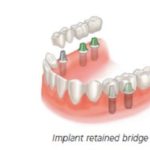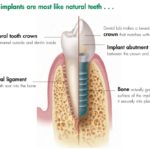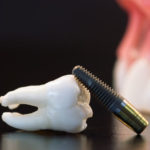We always tell our patients thank goodness for implants! With an approximate 93-96% success rate, we feel confident that an implant will be with our patient for the rest of their life. In many cases we would place a filling and have to replace it again in another 6 months because oral hygiene was poor, medications induced havoc with low saliva pH, and extreme dry mouth that could not naturally aid in cleaning the teeth. We are always so thankful for implants because they cannot get decay. We can remove crowns attached to the implant and make removable appliances to replace teeth (see “implant dentures”). Bottom line is that although it will be used as a single tooth replacement now, implants can grow with you and be used throughout your life with many options.
With an approximate 93-96% success rate, we feel confident that an implant will be with our patient for the rest of their life.
The Process: A tooth implant is a titanium screw that is placed in the extracted tooth socket and fuses to the existing natural bone. If there was a large infection or poor bone support in area where tooth was extracted, a bone graft may first be needed to re-establish bony support. However, in most cases, the tooth can be extracted and the implant placed same day. In ideal esthetic regions with outstanding bone support and no infection, a temporary tooth can even be placed on the implant same day. The implant is then covered with the gum tissue and allowed to heal for 4-6 months. After this healing period, the implant is then uncovered and a healing cap is placed to help form gum tissue support. At this time, the implant is ready for impressions and a custom connector (called an abutment) and crown can be made as the final restoration. Start to finish; an implant usually takes 10-12 months. It is well worth it knowing you have a bionic tooth that can never have a cavity again and is fully fused to your bone.
As a freestanding tooth replacement, the implant can be brushed and flossed like a natural tooth. There are no special aids needed. We cannot emphasize the point enough that you do still need to brush and floss it. Even though it cannot get a cavity, the gum tissue and underlying bone is still sensitive to calculus buildup from poor plaque removal and the resulting gum tissue inflammation. It is similar to periodontitis where bone support can be lost due to inflammation. The phenomenon is called peri-implantitis and the implant can become infected or fall out as a result.
As perfect as it sounds, there are some points to touch on with implants. A majority of insurances do not cover the cost of implants or the restoration of them. They are the most expensive option but also the one that will have the least reoccurring fees as treatments need do not need to be done due to wear and decay.
In a healthy mouth with healthy teeth, there is a living ligament that connects the tooth to the bone and allows teeth to drift over time towards the front of the mouth. This accounts for the front teeth crowding that occurs in every senior adult. As teeth drift, the implant stays stagnant and will form a gap between the implant crown and the natural tooth in front. In order to correct the gap, either a new crown on the implant will need to be placed or a filling on the tooth in front.
There is also a screw that connects the custom abutment to the actual implant. With normal chewing forces and even quicker in grinder or clenchers, the screw will loosen, need to be replaced and retightened.
All in all, an implant is our recommendation if there is proper bony support and well worth the investment. Maintenance such as gap closure and screw replacement may be needed over the life of the implant but that is far less cost than replacing an entire 3-tooth bridge.









